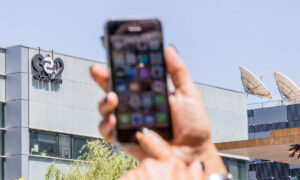Apple Tells Users Not to Hang up on Operators in Accidental 911 Calls
Apple issued an advisory on what iPhone or Apple Watch users should do if they accidentally call emergency services like 911 when they aren’t actually needed. Because the iPhone 14, Apple Watch Series 8, and Apple Watch Ultra support Apple’s Crash Detection feature that can determine if someone has been in a car accident, it can call emergency services automatically. According to a support document posted on Apple’s website that was updated on Wednesday: “Crash Detection is designed to detect severe car crashes—such as front-impact, side-impact, and rear-end collisions, and rollovers—involving sedans, minivans, SUVs, pickup trucks, and other passenger cars.” If a severe crash is detected, the iPhone or Watch will issue an alarm and provide an alert. “Your iPhone reads the alert, in case you can’t see the screen. If you have only your phone, the screen displays an Emergency Call slider and your phone can call emergency services,” it says. Or, the user’s Apple Watch will chime in with: “taps your wrist, and checks in with you on the screen. If you have only your watch, the screen displays an Emergency Call slider. If you have a watch with cellular or your watch is connected to Wi-Fi, it can call emergency services.” But if the alert is sounded accidentally or if “you don’t need emergency services, don’t hang up. Wait until a responder answers, then explain that you don’t need help,” said Wednesday’s change to the support document, which was initially posted to Apple’s website in September. The website MacRumors first reported on the change on Wednesday. According to Apple, iPhone users can turn off Crash Detection by going to the Settings app, then tapping Emergency SOS, and turning off Call After Severe Crash. Apple Watch users can turn it off by tapping the My Watch tab, tapping Emergency SOS, and turning off Call After Severe Crash. “Sensor data from your devices are used to detect severe car crashes,” Apple says. “All sensor data used to detect severe car crashes is processed on device and discarded after a crash is detected, unless you agree to share your data to improve Crash Detection. For example, the microphone on your iPhone is used to detect loud sound levels, characteristic of crashes. If you agree to share your data to improve Crash Detection, the sound levels are shared with Apple.” Crash Detection was first rolled out on the iPhone 14 models that were released last year.

Apple issued an advisory on what iPhone or Apple Watch users should do if they accidentally call emergency services like 911 when they aren’t actually needed.
Because the iPhone 14, Apple Watch Series 8, and Apple Watch Ultra support Apple’s Crash Detection feature that can determine if someone has been in a car accident, it can call emergency services automatically.
According to a support document posted on Apple’s website that was updated on Wednesday: “Crash Detection is designed to detect severe car crashes—such as front-impact, side-impact, and rear-end collisions, and rollovers—involving sedans, minivans, SUVs, pickup trucks, and other passenger cars.”
If a severe crash is detected, the iPhone or Watch will issue an alarm and provide an alert.
“Your iPhone reads the alert, in case you can’t see the screen. If you have only your phone, the screen displays an Emergency Call slider and your phone can call emergency services,” it says. Or, the user’s Apple Watch will chime in with: “taps your wrist, and checks in with you on the screen. If you have only your watch, the screen displays an Emergency Call slider. If you have a watch with cellular or your watch is connected to Wi-Fi, it can call emergency services.”
But if the alert is sounded accidentally or if “you don’t need emergency services, don’t hang up. Wait until a responder answers, then explain that you don’t need help,” said Wednesday’s change to the support document, which was initially posted to Apple’s website in September. The website MacRumors first reported on the change on Wednesday.
According to Apple, iPhone users can turn off Crash Detection by going to the Settings app, then tapping Emergency SOS, and turning off Call After Severe Crash. Apple Watch users can turn it off by tapping the My Watch tab, tapping Emergency SOS, and turning off Call After Severe Crash.
“Sensor data from your devices are used to detect severe car crashes,” Apple says. “All sensor data used to detect severe car crashes is processed on device and discarded after a crash is detected, unless you agree to share your data to improve Crash Detection. For example, the microphone on your iPhone is used to detect loud sound levels, characteristic of crashes. If you agree to share your data to improve Crash Detection, the sound levels are shared with Apple.”
Crash Detection was first rolled out on the iPhone 14 models that were released last year.












